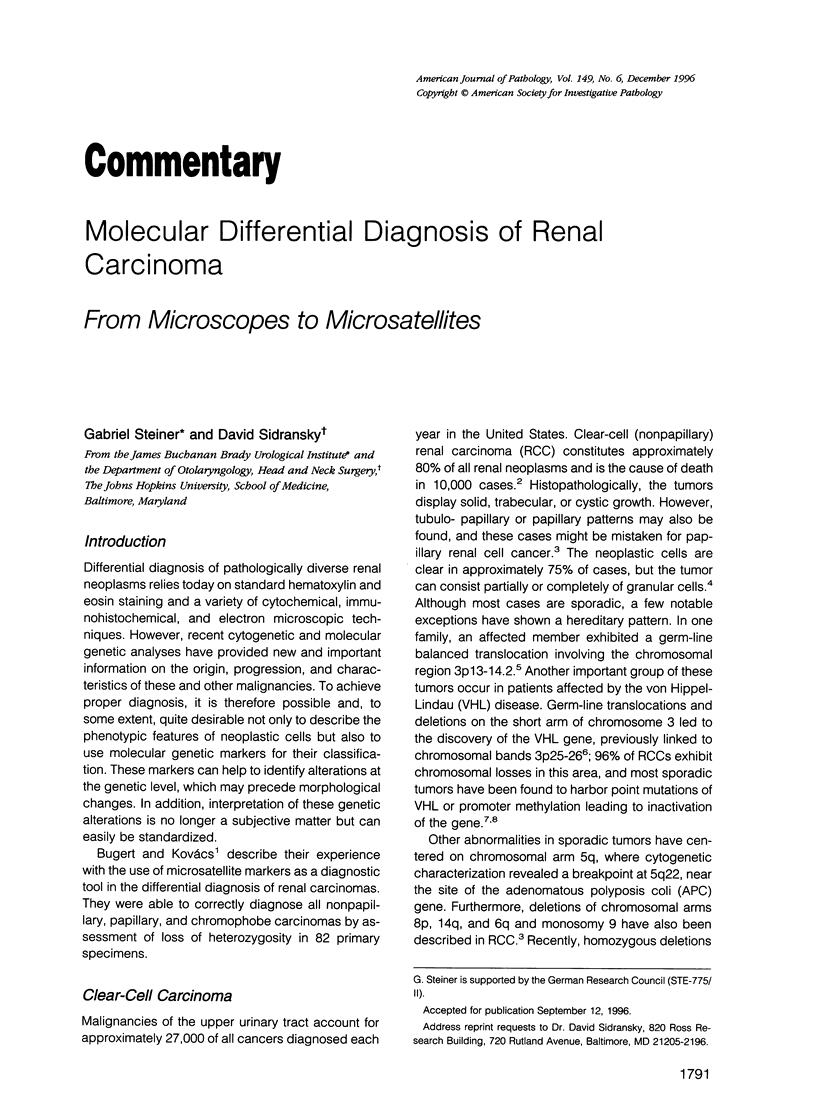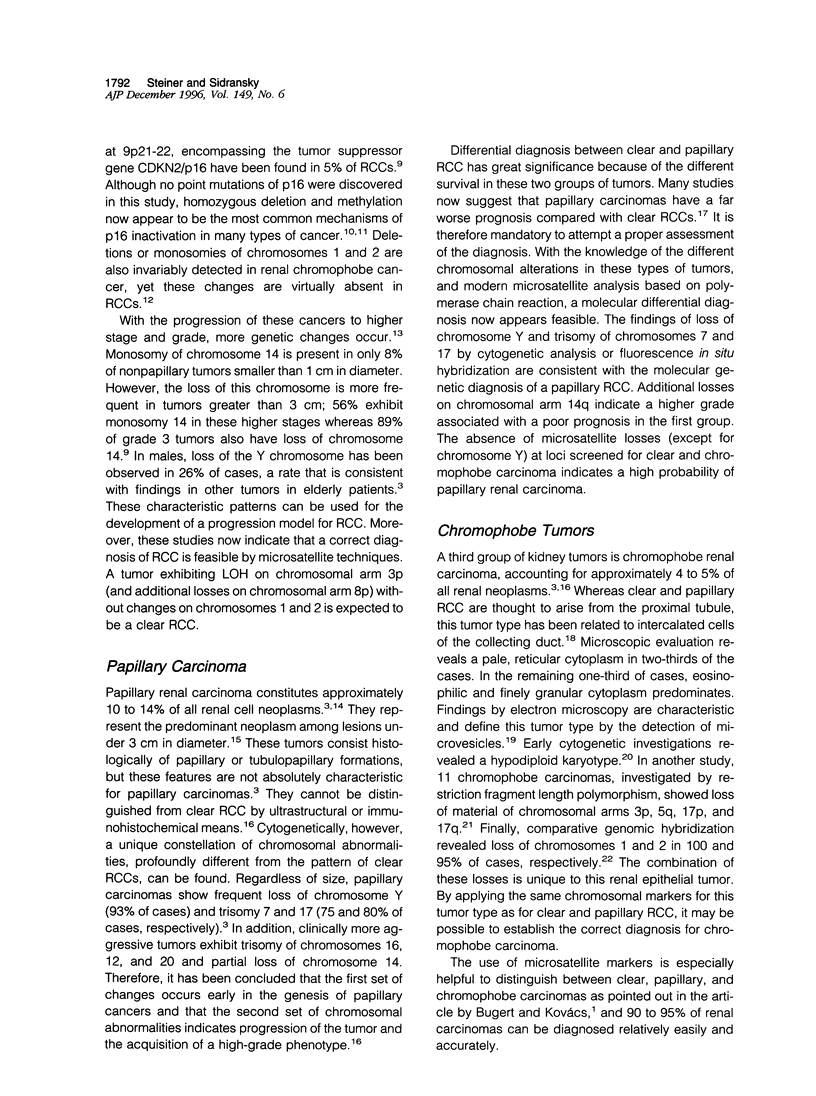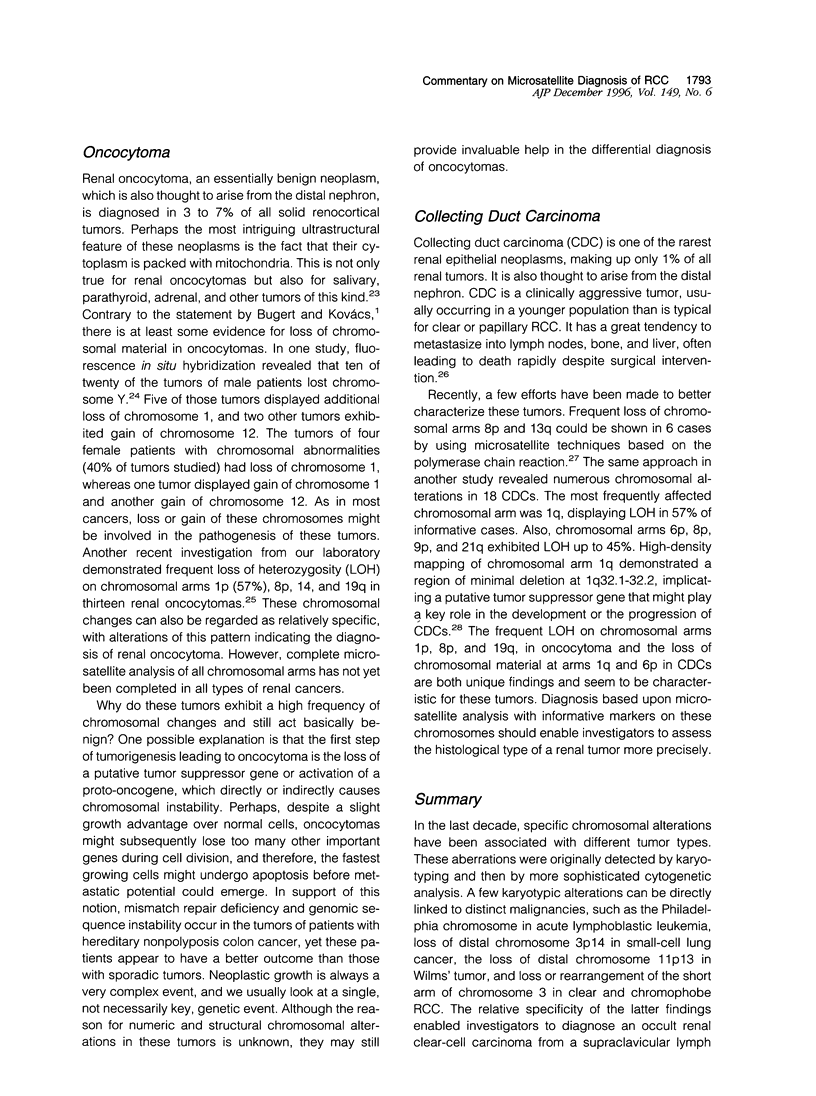Abstract
In the last decade, specific chromosomal alterations have been associated with different tumor types. These aberrations were originally detected by karyotyping and then by more sophisticated cytogenetic analysis. A few karyotypic alterations can be directly linked to distinct malignancies, such as the Philadelphia chromosome in acute lymphoblastic leukemia, loss of distal chromosome 3p 14 in small-cell lung cancer, the loss of distal chromosome 11p13 in Wilms' tumor, and loss or rearrangement of the short arm of chromosome 3 in clear and chromophobe RCC. The relative specificity of the latter findings enabled investigators to diagnose an occult renal clear-cell carcinoma from a supraclavicular lymph node metastasis by analysis of G-banded metaphase chromosomes obtained from this mass. A similar report based also on cytogenetic findings was published earlier. Karyotypic changes, however, detect only gross alterations visible to an observer. With more refined diagnostic tools, such as microsatellite analysis, other, even smaller, well defined lesions can be analyzed. A summary of the known frequencies of chromosomal losses is given in Table 1. The combination of certain LOH patterns has shown great promise in the differential diagnosis of renal tumors. The transfer of molecular genetics from the laboratory to surgical pathology and other clinical departments is a meaningful event and a challenging task. Molecular pathology is certain to become important in the diagnosis of tumors with unclear histology. Diagnosis based widely upon staining techniques and determination of a patient's prognosis by staging and grading alone will be increasingly accompanied by molecular genetic methods. Pathology may be on the verge of the greatest change since the introduction of the microscope.
Full text
PDF




Selected References
These references are in PubMed. This may not be the complete list of references from this article.
- Brown J. A., Takahashi S., Alcaraz A., Borell T. J., Anderl K. L., Qian J., Persons D. L., Bostwick D. G., Lieber M. M., Jenkins R. B. Fluorescence in situ hybridization analysis of renal oncocytoma reveals frequent loss of chromosomes Y and 1. J Urol. 1996 Jul;156(1):31–35. [PubMed] [Google Scholar]
- Bugert P., Kovacs G. Molecular differential diagnosis of renal cell carcinomas by microsatellite analysis. Am J Pathol. 1996 Dec;149(6):2081–2088. [PMC free article] [PubMed] [Google Scholar]
- Cairns P., Polascik T. J., Eby Y., Tokino K., Califano J., Merlo A., Mao L., Herath J., Jenkins R., Westra W. Frequency of homozygous deletion at p16/CDKN2 in primary human tumours. Nat Genet. 1995 Oct;11(2):210–212. doi: 10.1038/ng1095-210. [DOI] [PubMed] [Google Scholar]
- Cairns P., Tokino K., Eby Y., Sidransky D. Localization of tumor suppressor loci on chromosome 9 in primary human renal cell carcinomas. Cancer Res. 1995 Jan 15;55(2):224–227. [PubMed] [Google Scholar]
- Cohen A. J., Li F. P., Berg S., Marchetto D. J., Tsai S., Jacobs S. C., Brown R. S. Hereditary renal-cell carcinoma associated with a chromosomal translocation. N Engl J Med. 1979 Sep 13;301(11):592–595. doi: 10.1056/NEJM197909133011107. [DOI] [PubMed] [Google Scholar]
- Dal Cin P., Sciot R., De Wever I., Van Damme B., Van den Berghe H. Diagnosis of primary renal cell carcinoma in a left supraclavicular lymph node by chromosome analysis. J Urol. 1996 Jul;156(1):171–172. doi: 10.1097/00005392-199607000-00055. [DOI] [PubMed] [Google Scholar]
- Dimopoulos M. A., Logothetis C. J., Markowitz A., Sella A., Amato R., Ro J. Collecting duct carcinoma of the kidney. Br J Urol. 1993 Apr;71(4):388–391. doi: 10.1111/j.1464-410x.1993.tb15978.x. [DOI] [PubMed] [Google Scholar]
- Fuhrman S. A., Lasky L. C., Limas C. Prognostic significance of morphologic parameters in renal cell carcinoma. Am J Surg Pathol. 1982 Oct;6(7):655–663. doi: 10.1097/00000478-198210000-00007. [DOI] [PubMed] [Google Scholar]
- Gnarra J. R., Tory K., Weng Y., Schmidt L., Wei M. H., Li H., Latif F., Liu S., Chen F., Duh F. M. Mutations of the VHL tumour suppressor gene in renal carcinoma. Nat Genet. 1994 May;7(1):85–90. doi: 10.1038/ng0594-85. [DOI] [PubMed] [Google Scholar]
- Herman J. G., Latif F., Weng Y., Lerman M. I., Zbar B., Liu S., Samid D., Duan D. S., Gnarra J. R., Linehan W. M. Silencing of the VHL tumor-suppressor gene by DNA methylation in renal carcinoma. Proc Natl Acad Sci U S A. 1994 Oct 11;91(21):9700–9704. doi: 10.1073/pnas.91.21.9700. [DOI] [PMC free article] [PubMed] [Google Scholar]
- Kovacs A., Storkel S., Thoenes W., Kovacs G. Mitochondrial and chromosomal DNA alterations in human chromophobe renal cell carcinomas. J Pathol. 1992 Jul;167(3):273–277. doi: 10.1002/path.1711670303. [DOI] [PubMed] [Google Scholar]
- Kovacs G., Frisch S. Clonal chromosome abnormalities in tumor cells from patients with sporadic renal cell carcinomas. Cancer Res. 1989 Feb 1;49(3):651–659. [PubMed] [Google Scholar]
- Kovacs G. Molecular cytogenetics of renal cell tumors. Adv Cancer Res. 1993;62:89–124. doi: 10.1016/s0065-230x(08)60316-4. [DOI] [PubMed] [Google Scholar]
- Kovacs G. Molecular differential pathology of renal cell tumours. Histopathology. 1993 Jan;22(1):1–8. doi: 10.1111/j.1365-2559.1993.tb00061.x. [DOI] [PubMed] [Google Scholar]
- Latif F., Tory K., Gnarra J., Yao M., Duh F. M., Orcutt M. L., Stackhouse T., Kuzmin I., Modi W., Geil L. Identification of the von Hippel-Lindau disease tumor suppressor gene. Science. 1993 May 28;260(5112):1317–1320. doi: 10.1126/science.8493574. [DOI] [PubMed] [Google Scholar]
- Lieber M. M. Renal oncocytoma. Urol Clin North Am. 1993 May;20(2):355–359. [PubMed] [Google Scholar]
- Merlo A., Herman J. G., Mao L., Lee D. J., Gabrielson E., Burger P. C., Baylin S. B., Sidransky D. 5' CpG island methylation is associated with transcriptional silencing of the tumour suppressor p16/CDKN2/MTS1 in human cancers. Nat Med. 1995 Jul;1(7):686–692. doi: 10.1038/nm0795-686. [DOI] [PubMed] [Google Scholar]
- O'Toole K. M., Brown M., Hoffmann P. Pathology of benign and malignant kidney tumors. Urol Clin North Am. 1993 May;20(2):193–205. [PubMed] [Google Scholar]
- Peier A. M., Meloni A. M., Sandberg A. A., Leong S. P., Carroll P. R. Cytogenetic findings in a metastatic renal cell carcinoma. Cancer Genet Cytogenet. 1995 Apr;80(2):168–169. doi: 10.1016/0165-4608(94)00144-z. [DOI] [PubMed] [Google Scholar]
- Polascik T. J., Cairns P., Epstein J. I., Fuzesi L., Ro J. Y., Marshall F. F., Sidransky D., Schoenberg M. Distal nephron renal tumors: microsatellite allelotype. Cancer Res. 1996 Apr 15;56(8):1892–1895. [PubMed] [Google Scholar]
- Schoenberg M., Cairns P., Brooks J. D., Marshall F. F., Epstein J. I., Isaacs W. B., Sidransky D. Frequent loss of chromosome arms 8p and 13q in collecting duct carcinoma (CDC) of the kidney. Genes Chromosomes Cancer. 1995 Jan;12(1):76–80. doi: 10.1002/gcc.2870120115. [DOI] [PubMed] [Google Scholar]
- Speicher M. R., Schoell B., du Manoir S., Schröck E., Ried T., Cremer T., Störkel S., Kovacs A., Kovacs G. Specific loss of chromosomes 1, 2, 6, 10, 13, 17, and 21 in chromophobe renal cell carcinomas revealed by comparative genomic hybridization. Am J Pathol. 1994 Aug;145(2):356–364. [PMC free article] [PubMed] [Google Scholar]
- Störkel S., Steart P. V., Drenckhahn D., Thoenes W. The human chromophobe cell renal carcinoma: its probable relation to intercalated cells of the collecting duct. Virchows Arch B Cell Pathol Incl Mol Pathol. 1989;56(4):237–245. doi: 10.1007/BF02890022. [DOI] [PubMed] [Google Scholar]
- Thoenes W., Störkel S., Rumpelt H. J. Histopathology and classification of renal cell tumors (adenomas, oncocytomas and carcinomas). The basic cytological and histopathological elements and their use for diagnostics. Pathol Res Pract. 1986 May;181(2):125–143. doi: 10.1016/S0344-0338(86)80001-2. [DOI] [PubMed] [Google Scholar]
- Thoenes W., Störkel S., Rumpelt H. J., Moll R., Baum H. P., Werner S. Chromophobe cell renal carcinoma and its variants--a report on 32 cases. J Pathol. 1988 Aug;155(4):277–287. doi: 10.1002/path.1711550402. [DOI] [PubMed] [Google Scholar]
- Weiss L. M., Gelb A. B., Medeiros L. J. Adult renal epithelial neoplasms. Am J Clin Pathol. 1995 May;103(5):624–635. doi: 10.1093/ajcp/103.5.624. [DOI] [PubMed] [Google Scholar]


